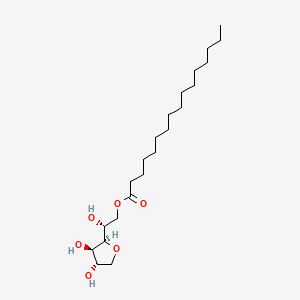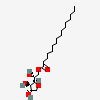Sorbitan monopalmitate
- Span 40
- SORBITAN MONOPALMITATE
- Arlacel 40
- 26266-57-9
- Sorbitan palmitate
- Create:2007-07-12
- Modify:2025-01-18

- sorbitan monohexadecanoate
- sorbitan monopalmitate
- sorbitan palmitate
- Span 40
- Span 40
- SORBITAN MONOPALMITATE
- Arlacel 40
- 26266-57-9
- Sorbitan palmitate
- Palmitate de sorbitan
- Sorbitan monohexadecanoate
- Sorbitan palmitate [INN]
- INS NO.495
- Glycomul P
- Liposorb P
- Protachem SMP
- Sorbitan palmitas
- INS-495
- 77K6Z421KU
- Crill 2
- Montane 40
- Nikkol SP10
- Nonion PP40
- Sorgen 70
- Nissan nonion PP40
- Rheodol SP-P 10
- Sorbitan, monopalmitate
- Emsorb 2510
- 1,4-Anhydro-D-glucitol, 6-hexadecanoate
- Nissan nonion PP 40R
- D-Glucitol, 1,4-anhydro-, 6-hexadecanoate
- E-495
- Sorbitani palmitas
- (R)-2-((2R,3R,4S)-3,4-dihydroxytetrahydrofuran-2-yl)-2-hydroxyethyl palmitate
- [(2R)-2-[(2R,3R,4S)-3,4-dihydroxyoxolan-2-yl]-2-hydroxyethyl] hexadecanoate
- Palmitato de sorbitano
- UNII-77K6Z421KU
- Sorbitani palmitas [INN-Latin]
- Sorbitan monopalmitate [USAN:NF]
- NCGC00181308-01
- EINECS 247-568-8
- Palmitate de sorbitan [INN-French]
- Palmitato de sorbitan
- Palmitato de sorbitano [INN-Spanish]
- AI3-03901
- DSSTox_CID_9335
- EC 247-568-8
- DSSTox_RID_78767
- DSSTox_GSID_29335
- CHEMBL3186294
- SCHEMBL13700731
- DTXSID90873164
- (2R)-2-[(2R,3R,4S)-3,4-dihydroxyoxolan-2-yl]-2-hydroxyethyl hexadecanoate
- CHEBI:190605
- IYFATESGLOUGBX-YVNJGZBMSA-N
- SORBITAN MONOPALMITATE [II]
- SORBITAN PALMITATE [MART.]
- SORBITAN MONOPALMITATE [FCC]
- Span 40 (=Sorbitan Monopalmitate)
- Tox21_112783
- SORBITAN MONOPALMITATE [USAN]
- 1,4-anhydro-6-O-palmitoyl-D-glucitol
- HY-W129513
- SORBITAN PALMITATE [EP MONOGRAPH]
- 1,4-Anhydro-6-O-hexadecanoyl-D-glucitol
- DA-58030
- CAS-26266-57-9
- CS-0187643
- S0061
 Green circle - The chemical has been verified to be of low concern
Green circle - The chemical has been verified to be of low concern- Intermediate
- Lubricating agent
- Solids separation (precipitating) agent, not otherwise specified
- Surfactant (surface active agent)
- Agricultural chemicals (non-pesticidal)
- Surface active agents
- Demulsifier
- Processing aids not otherwise specified
Information on 1 consumer products that contain Sorbitan Palmitate in the following categories is provided:
• Personal Care
2019: 1,733,651 lb
2018: 1,621,703 lb
2017: 1,513,332 lb
2016: 1,399,375 lb
- Utilities
- Not Known or Reasonably Ascertainable
- Textiles, apparel, and leather manufacturing
- Petroleum Lubricating Oil and Grease Manufacturing
- All Other Basic Organic Chemical Manufacturing
- Paint and Coating Manufacturing
- Pesticide, Fertilizer, and Other Agricultural Chemical Manufacturing

H315 (23.6%): Causes skin irritation [Warning Skin corrosion/irritation]
H319 (23.6%): Causes serious eye irritation [Warning Serious eye damage/eye irritation]
H335 (22.4%): May cause respiratory irritation [Warning Specific target organ toxicity, single exposure; Respiratory tract irritation]
P261, P264, P264+P265, P271, P280, P302+P352, P304+P340, P305+P351+P338, P319, P321, P332+P317, P337+P317, P362+P364, P403+P233, P405, and P501
(The corresponding statement to each P-code can be found at the GHS Classification page.)
Aggregated GHS information provided per 174 reports by companies from 6 notifications to the ECHA C&L Inventory. Each notification may be associated with multiple companies.
Reported as not meeting GHS hazard criteria per 128 of 174 reports by companies. For more detailed information, please visit ECHA C&L website.
There are 5 notifications provided by 46 of 174 reports by companies with hazard statement code(s).
Information may vary between notifications depending on impurities, additives, and other factors. The percentage value in parenthesis indicates the notified classification ratio from companies that provide hazard codes. Only hazard codes with percentage values above 10% are shown.
Skin Irrit. 2 (23.6%)
Eye Irrit. 2 (23.6%)
STOT SE 3 (22.4%)
Chemical: Sorbitan monopalmitate

Status: Active Update: 29-09-2022 https://echa.europa.eu/registration-dossier/-/registered-dossier/12294
Status: Active Update: 17-05-2013 https://echa.europa.eu/registration-dossier/-/registered-dossier/6255
Patents are available for this chemical structure:
https://patentscope.wipo.int/search/en/result.jsf?inchikey=IYFATESGLOUGBX-YVNJGZBMSA-N
- Australian Industrial Chemicals Introduction Scheme (AICIS)Sorbitan, monohexadecanoatehttps://services.industrialchemicals.gov.au/search-assessments/Sorbitan, monohexadecanoatehttps://services.industrialchemicals.gov.au/search-inventory/
- CAS Common ChemistryLICENSEThe data from CAS Common Chemistry is provided under a CC-BY-NC 4.0 license, unless otherwise stated.https://creativecommons.org/licenses/by-nc/4.0/
- ChemIDplusSorbitan monopalmitate [USAN:NF]https://pubchem.ncbi.nlm.nih.gov/substance/?source=chemidplus&sourceid=0026266579ChemIDplus Chemical Information Classificationhttps://pubchem.ncbi.nlm.nih.gov/source/ChemIDplus
- EPA Chemical Data Reporting (CDR)LICENSEThe U.S. Government retains a nonexclusive, royalty-free license to publish or reproduce these documents, or allow others to do so, for U.S. Government purposes. These documents may be freely distributed and used for non-commercial, scientific and educational purposes.https://www.epa.gov/web-policies-and-procedures/epa-disclaimers#copyrightSorbitan, monohexadecanoatehttps://www.epa.gov/chemical-data-reporting
- EPA Chemicals under the TSCASorbitan, monohexadecanoatehttps://www.epa.gov/chemicals-under-tscaEPA TSCA Classificationhttps://www.epa.gov/tsca-inventory
- EPA DSSTox1,4-Anhydro-6-O-hexadecanoyl-D-glucitolhttps://comptox.epa.gov/dashboard/DTXSID90873164CompTox Chemicals Dashboard Chemical Listshttps://comptox.epa.gov/dashboard/chemical-lists/
- European Chemicals Agency (ECHA)LICENSEUse of the information, documents and data from the ECHA website is subject to the terms and conditions of this Legal Notice, and subject to other binding limitations provided for under applicable law, the information, documents and data made available on the ECHA website may be reproduced, distributed and/or used, totally or in part, for non-commercial purposes provided that ECHA is acknowledged as the source: "Source: European Chemicals Agency, http://echa.europa.eu/". Such acknowledgement must be included in each copy of the material. ECHA permits and encourages organisations and individuals to create links to the ECHA website under the following cumulative conditions: Links can only be made to webpages that provide a link to the Legal Notice page.https://echa.europa.eu/web/guest/legal-noticeSorbitan palmitatehttps://chem.echa.europa.eu/100.043.229Sorbitan palmitate (EC: 247-568-8)https://echa.europa.eu/information-on-chemicals/cl-inventory-database/-/discli/details/128999
- FDA Global Substance Registration System (GSRS)LICENSEUnless otherwise noted, the contents of the FDA website (www.fda.gov), both text and graphics, are not copyrighted. They are in the public domain and may be republished, reprinted and otherwise used freely by anyone without the need to obtain permission from FDA. Credit to the U.S. Food and Drug Administration as the source is appreciated but not required.https://www.fda.gov/about-fda/about-website/website-policies#linkingSORBITAN MONOPALMITATEhttps://gsrs.ncats.nih.gov/ginas/app/beta/substances/77K6Z421KU
- New Zealand Environmental Protection Authority (EPA)LICENSEThis work is licensed under the Creative Commons Attribution-ShareAlike 4.0 International licence.https://www.epa.govt.nz/about-this-site/general-copyright-statement/
- ChEBISorbitan monopalmitatehttps://www.ebi.ac.uk/chebi/searchId.do?chebiId=CHEBI:190605
- ChEMBLLICENSEAccess to the web interface of ChEMBL is made under the EBI's Terms of Use (http://www.ebi.ac.uk/Information/termsofuse.html). The ChEMBL data is made available on a Creative Commons Attribution-Share Alike 3.0 Unported License (http://creativecommons.org/licenses/by-sa/3.0/).http://www.ebi.ac.uk/Information/termsofuse.html
- Consumer Product Information Database (CPID)LICENSECopyright (c) 2024 DeLima Associates. All rights reserved. Unless otherwise indicated, all materials from CPID are copyrighted by DeLima Associates. No part of these materials, either text or image may be used for any purpose other than for personal use. Therefore, reproduction, modification, storage in a retrieval system or retransmission, in any form or by any means, electronic, mechanical or otherwise, for reasons other than personal use, is strictly prohibited without prior written permission.https://www.whatsinproducts.com/contents/view/1/6Sorbitan Palmitatehttps://www.whatsinproducts.com/chemicals/view/1/7236/026266-57-9Consumer Products Category Classificationhttps://www.whatsinproducts.com/
- Cosmetic Ingredient Review (CIR)
- NORMAN Suspect List ExchangeLICENSEData: CC-BY 4.0; Code (hosted by ECI, LCSB): Artistic-2.0https://creativecommons.org/licenses/by/4.0/NORMAN Suspect List Exchange Classificationhttps://www.norman-network.com/nds/SLE/
- EU Food Improvement AgentsSORBITAN MONOPALMITATEhttp://data.europa.eu/eli/reg/2012/231/2024-04-23
- EPA Safer ChoiceSorbitan monopalmitatehttps://www.epa.gov/saferchoice/safer-ingredientsEPA Safer Chemical Ingredients Classificationhttps://www.epa.gov/saferchoice
- Joint FAO/WHO Expert Committee on Food Additives (JECFA)LICENSEPermission from WHO is not required for the use of WHO materials issued under the Creative Commons Attribution-NonCommercial-ShareAlike 3.0 Intergovernmental Organization (CC BY-NC-SA 3.0 IGO) licence.https://www.who.int/about/policies/publishing/copyrightSORBITAN MONOPALMITATEhttps://apps.who.int/food-additives-contaminants-jecfa-database/Home/Chemical/3009
- KEGGLICENSEAcademic users may freely use the KEGG website. Non-academic use of KEGG generally requires a commercial licensehttps://www.kegg.jp/kegg/legal.html
- Metabolomics WorkbenchSorbitan palmitatehttps://www.metabolomicsworkbench.org/data/StructureData.php?RegNo=44104
- NCI Thesaurus (NCIt)LICENSEUnless otherwise indicated, all text within NCI products is free of copyright and may be reused without our permission. Credit the National Cancer Institute as the source.https://www.cancer.gov/policies/copyright-reuseNCI Thesaurushttps://ncit.nci.nih.gov
- NLM RxNorm TerminologyLICENSEThe RxNorm Terminology is created by the National Library of Medicine (NLM) and is in the public domain and may be republished, reprinted and otherwise used freely by anyone without the need to obtain permission from NLM. Credit to the U.S. National Library of Medicine as the source is appreciated but not required. The full RxNorm dataset requires a free license.https://www.nlm.nih.gov/research/umls/rxnorm/docs/termsofservice.htmlsorbitan monopalmitatehttps://rxnav.nlm.nih.gov/id/rxnorm/1363701
- Springer Nature
- Wikidatasorbitan monopalmitatehttps://www.wikidata.org/wiki/Q13000701,4-Anhydro-6-O-hexadecanoyl-D-glucitolhttps://www.wikidata.org/wiki/Q81978723
- PubChem
- Medical Subject Headings (MeSH)LICENSEWorks produced by the U.S. government are not subject to copyright protection in the United States. Any such works found on National Library of Medicine (NLM) Web sites may be freely used or reproduced without permission in the U.S.https://www.nlm.nih.gov/copyright.htmlsorbitan monopalmitatehttps://www.ncbi.nlm.nih.gov/mesh/67061705
- GHS Classification (UNECE)GHS Classification Treehttp://www.unece.org/trans/danger/publi/ghs/ghs_welcome_e.html
- MolGenieMolGenie Organic Chemistry Ontologyhttps://github.com/MolGenie/ontology/
- PATENTSCOPE (WIPO)SID 403030921https://pubchem.ncbi.nlm.nih.gov/substance/403030921
